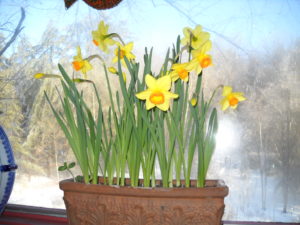Forcing Bulbs
Each fall I pot up daffodils, tulips, crocus and other bulbs for indoor blooming. Now is the time to do it. It takes a long time for bulbs to establish roots and get ready to bloom, come spring, so the sooner you do so the better. Most bulbs need three to four months before they are ready.
Most bulb packages will specify early, mid-season or late blooming times. When selecting bulbs for forcing, choose early-blooming or mid-season varieties. Species tulips like Fosteriana and Kaufmanniana are both early. The Darwin hybrids are early- to mid-season varieties that force well. Triumph tulips are also good.
Of the early daffodils my favorite is Tete-a-Tete which produces small gold flowers, 2 or 3 blossoms per bulb. These are readily available in grocery stores in early spring and I buy them already blooming in small pots for under $5. One of my favorite things to do with them is to put a pot in a rubber boot in the mudroom, their blossoms poking out of the boot. It always evokes a reaction from visitors.
So how do you force bulbs? Plant them in ordinary potting soil in pots and keep them in a cool spot that stays slightly above freezing, and never more than 50 degrees. I have a cold, above-ground basement that is perfect for that. But you can keep them in the garage or perhaps the bulkhead.
No harm is done if temperatures drop below freezing for part of the time they are getting ready, but no growth occurs when they are frozen, so keeping them above freezing is better.
Bulbs have everything they need to bloom already packaged inside. You don’t need to fertilize the bulbs when you plant. Each fall I clean out all the pots that had annual plants on the deck and save the potting mix in a big contractor bag. I use that potting material to fill other pots for forcing bulbs.
Mice can be an issue if planting tulips or crocus, though daffodils and alliums are of no interest to them. I cut squares of plywood large enough to cover any pots I use for tulips. I put a brick on top of the plywood to keep mice out – they can squeeze through incredibly small spaces.
Most gardening books warn against watering the soil mix in which you have planted bulbs. They say bulbs will rot if too wet. That may be true, but I’ve found that in winter my problem has been more with the soil drying out too much. Humidity is very low in winter, and the potting mix, which is peat-based, loses moisture quickly by evaporation. I check the soil once a month and water if the soil feels dry. One year I let the mix dry out to much and did not get many blossoms. Always start with lightly moist soil mix.
Clay pots may look good to you, but they can allow moisture to evaporate quickly from the sides of the pot. Plastic, fiber glass or porcelain containers are better for bulbs because they hold the moisture of the potting mix, minimizing water loss.
So how close can you plant your bulbs? Basically as close as you want. I have some nice Italian pots that I use each year for forcing. They are rectangular, roughly 14 inches long, seven inches wide and six inches deep. I put 8 to 10 bulbs in each one. In a 10-inch round pot I put 10 daffodils. An inch or two between bulbs is fine.
Most pots do not allow the same planting depth you would have outside. Instead of 6 inches of soil covering a tulip or a daffodil, two or three inches is fine. I put a thick layer of soil in the bottom of the pot, then arrange the bulbs on it. I push down on each bulb to set if firmly in place, and then cover with soil mix. A light watering is good after patting the top of the soil to firm it up a bit.
If you do have a deep pot – 10 inches or so – you can plant 2 layers of bulbs. Plant daffodils near the bottom of the pot, add soil mix, and then add some small bulbs like crocus or snowdrops near the soil surface. Just leave a little more space between the small bulbs than you might otherwise so that the daffodils can grow up between them.
How do you know when your bulbs are ready to bring into the warmth of the house? Make a tag for each pot that tells you what is planted, and when it was planted. Eight to twelve weeks is fine for daffodils, and 16 weeks for tulips. But look at the pots. If buds are up and craving light, bring them up a little early if you wish. But never bring tulips up before the end of February or they won’t bloom.
Winter is often a hard time for gardeners. We crave working in the soil and seeing things grow. Forcing bulbs indoors is one way we can satisfy our need to have flowers – even with snow on the ground.
You may reach Henry at PO Box 364, Cornish Flat, NH 03746. Please include a SASE if you want a written reply. Better yet, e-mail him at henry.homeyer@comcast.net. You may read his blog posts at https://dailyuv.com/





